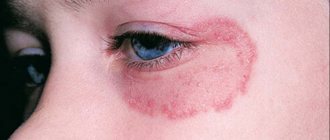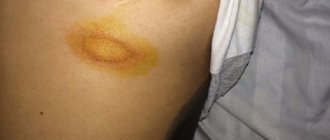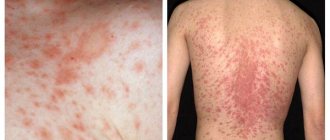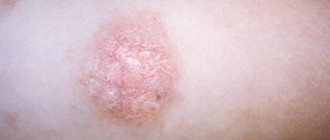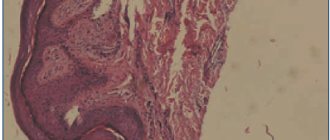Description of the disease
Depending on the type of lichen, the rash may be dry or weeping, pale pink or bright red.
Most often, the disease affects the back, face and chest of the child (it is in these areas that the largest number of sweat glands are located). The disease is infectious in origin and is caused by viruses or fungi. The disease most often manifests itself in the spring-summer season, when it is warm and humid outside. At the moment, a large number of varieties of lichen are known. Many of them are highly contagious and potentially dangerous to the child’s immediate environment. That is why, if there is any suspicion of an infectious disease, it is necessary to immediately show the patient to a qualified specialist.
Symptoms of lichen
The clinical picture of the disease directly depends on its form. There are 5 most common variants of lichen: pink, multi-colored, red flat, ringworm, shingles.
- Manifestations of pityriasis rosea. This type is characterized by the appearance on the child’s skin of a single pink plaque with a diameter of 3-4 cm. The formation is prone to peeling and provokes moderate itching. A week after the plaque appears, multiple daughter rashes form on the child’s skin. Pityriasis rosea often affects a child's back, shoulders and abdomen. Often the rash is localized in natural folds and curves.
- Symptoms of versicolor.
Tinea versicolor usually occurs on the child's scalp or upper half of the body. This is one of the few varieties that affects only the upper layer of the epidermis and is not transmitted by contact. At the very beginning of the disease, lichen can be suspected by the appearance of small spots of pink, yellow or brownish color. Then the spots that appear gradually grow, forming large lesions with jagged edges. Lichen versicolor got its name due to its distinctive feature: focal rashes can change color over time, becoming dark brown or dark brown spots. In addition, this form has another distinctive feature - the skin elements are not accompanied by itching or burning of the skin, and therefore do not cause the child much discomfort. - Manifestations of lichen planus.
With this form, scaly spots of bright red or dark brown color appear on the mucous membranes or skin of the child. The disease can be identified by severe itching, which significantly reduces the child’s quality of life, and by the characteristic depressions in the middle of each rash. In most cases, formations are localized on the skin in the area of natural folds, stomach and back. After recovery, long-lasting pigment spots may remain at the site of the rash. - Clinical picture of ringworm.
Ringworm is the most common form of the disease in children and adolescents. Pathology develops on the skin, nails, scalp and hair itself. The skin is affected by reddish round spots, accompanied by peeling and itching. If lichen affects the scalp, this is accompanied by the appearance of a fairly large area of baldness, at the edges of which the hair breaks off at a level of 0.5-1 cm from the dermis (taking on a trimmed appearance). In addition to the main formation, multiple small lesions may occur. - Symptoms of herpes zoster.
This form predominantly occurs in older adolescents who have previously had chickenpox. Before the appearance of skin rashes, the patient experiences the following symptoms: weakness, drowsiness, chills, increased body temperature to subfebrile levels. The onset of the disease is often confused with influenza or ARVI.
A few days later, multiple rashes filled with clear liquid content appear on the child’s skin in the area where large nerve trunks and branches pass. Then the bubbles dry out, darken, and become crusty.
Pityriasis rosea: symptoms
The main symptom is pink, scaly spots that appear gradually. The disease begins with the appearance of one spot (maternal plaque) measuring 2 cm. After about a week, multiple pink spots of different diameters appear (smaller than the maternal plaque).
Location of rashes: pityriasis rosea appears on the face and other areas of the skin (sides of the body, back, shoulders, etc.). Peeling appears in the center, and a red border remains around the circumference. Individual spots may merge with each other. Patients may also be bothered by itching of varying intensity and increased body temperature (in cases with complications).
Sometimes pityriasis rosea has atypical forms with symptoms such as blistering, dotted and draining rashes in small quantities, but the spots can reach large sizes and also become chronic.
Pityriasis rosea: causes
As mentioned above, the causes of the disease are not fully understood. Perhaps it is a viral disease; pathogens like herpes are sometimes cited as the cause.
What else causes pityriasis rosea?
As a rule, this is a standard set of reasons that lead to a decrease in immunity and disruption of the normal functioning of the body’s protective functions, namely:
- past infections and diseases;
- colds;
- diseases of the gastrointestinal tract and endocrine system;
- stress and nervous tension;
- change of climate and time zone;
- allergic reactions;
- metabolic disease;
- insect bites, etc.
The medical department provides comprehensive diagnosis and treatment of skin diseases of various levels of complexity and causes. For diagnosis and treatment, dermatologists use specialized expert clinical and clinical-biochemical microscopy, as well as dermatoscopy and cultural diagnostics.
Initial appointment
Treatment of pityriasis rosea in children and adults begins with the first consultation with a specialist. As a rule, already at the first examination, the doctor can make a diagnosis and prescribe a course of treatment with a plan of individual visits according to each specific clinical case.
If the disease is severe or has complications and concurrent infections, then appropriate tests and examinations are prescribed.
Diagnostics
Diagnostics includes:
- examination of the patient by a dermatologist;
- taking material for biopsy and histological examination to exclude parapsoriasis;
- scraping for bacteriological culture;
- scraping for pathogenic fungi;
- fluorescent diagnostics;
- conducting RPR tests for syphilis (in rare cases).
Repeated appointment
The main means of treating pityriasis rosea, its causes and consequences are ointments, gels and creams. But besides this (depending on the case) the patient:
- bathing is prohibited (only washing in the shower with gentle detergents is possible);
- It is advised to limit your time in the sun;
- It is advised to wear loose clothing made from natural materials;
- a hypoallergenic diet is prescribed during treatment and for some time after it;
- prescribe the use of antiallergic and anti-inflammatory ointments for severe itching;
- antibiotics are prescribed (in particularly difficult cases).
Since pityriasis rosea looks like an unpleasant and unaesthetic skin reaction, and can be contagious, it creates psychological discomfort in the patient. A common reaction to any skin rash is a reluctance to leave the house and communicate with people, embarrassment when communicating, isolation and detachment. Accordingly, if necessary, consultations with a psychotherapist or psychologist may be prescribed during treatment. If a dermatologist suspects a hormonal imbalance, an endocrinologist will also conduct a consultation.
If treatment of pityriasis rosea in an adult or child with ointments and other means has already been prescribed, then at a second appointment the doctor evaluates the results. If no improvement is observed, then a new course of treatment and restorative procedures are selected to strengthen the immune system.
Treatment of pityriasis rosea in children depends on the age of the child, his condition and the stage of development of the disease. Means and methods of combating the disease are also selected individually, but the treatment regimen is similar to that for adult patients. As a rule, a child recovers from a disease several times faster than an adult.
Control reception
A follow-up appointment is required 21–30 days after treatment to assess the patient’s condition and treatment results. If the outcome is positive, methods of restoring the patient are prescribed (physiotherapy, immunotherapy, etc.).
Treatment result
Achieving positive results is only possible if you strictly follow the doctor’s recommendations and prescriptions. The duration of treatment is also individual in each case and is discussed with the doctor at the appointment: treatment usually takes from 2 to 6 weeks. If the patient has excessive sweating or allergic reactions, the treatment period is increased.
Prevention
To avoid the need to treat pityriasis rosea in a person, he should be warned: with what and how?
Good prevention is:
- proper nutrition or a hypoallergenic diet if you are prone to allergic reactions;
- strengthening the immune system through sports and active recreation;
- wearing high-quality clothes made from natural materials;
- individual selection of cosmetics and care products for body and face;
- local therapy, including taking medications to strengthen the immune system;
- careful use of water procedures;
- wearing warm clothes in the off-season and cold season to avoid hypothermia.
Making a diagnosis on your own is not recommended, nor is it recommended to prescribe treatment on your own. How and with what to treat and cure pityriasis rosea, get rid of symptoms and prevent the causes of relapses, only a dermatologist
. So don't delay visiting your doctor. High-quality and timely prescription of a course of treatment will allow you to quickly get rid of the disease and significantly improve your quality of life.
To make an appointment with a dermatologist in our center, just leave a request on the website (there is a special registration form) or call the phone number listed on the page.
Reasons for deprivation
The main reason for the formation of lichen is associated with the penetration of a viral or fungal infection into the body.
However, the infection process itself has not been fully studied. Scientists remain unknown why not all children (even those at risk) suffer from lichen. Despite this, there are factors that increase the risk of developing the disease in a child:
- excessive emotional and physical stress;
- exposure to stress;
- decreased immunity;
- the presence of infectious inflammatory processes;
- avitaminosis;
- allergic reactions;
- increased sweating;
- hereditary predisposition.
Infection of children most often occurs in crowded places: kindergarten, school, summer camp, public swimming pool.
Also, a common cause of the development of lichen is contact with domestic or street animals, after which the rules of personal hygiene were not followed. Each form of lichen has specific causes. Thus, pityriasis rosea clearly shows an infectious-allergic nature. Shingles develops as a result of various types of viruses entering the body, ringworm and multicolored fungi.
What is pityriasis rosea?
Pityriasis rosea is a disease that is diagnosed in children and adults, but more often occurs in young people. The causative agent of the disease is unknown, but there is an assumption that the disease occurs as a result of the penetration of a virus into the body. Most often, skin ailments occur in the off-season (spring and autumn), when the immune system is weakened and the risk of catching a cold is increased.
Inflammation can go away on its own with complete disappearance of symptoms, and then in most cases the patient develops immunity to the disease. But if pityriasis rosea does not go away, then it becomes chronic. And then not just treatment is required, but the development of a special program to prevent frequent relapses and strengthen the patient’s immunity.
Is pityriasis rosea contagious or not, transmitted from person to person or not?
There are several assumptions about how a person can become infected with this disease:
- transmission from person to person by airborne droplets, but with strong immunity this is impossible;
- pityriasis rosea can occur as a result of the body's reaction to hypothermia (this is why the disease often occurs in spring and autumn);
- severe stress, prolonged nervous tension and other factors that undermine the body's defenses can also trigger pityriasis rosea.
Pityriasis rosea and pregnancy
In pregnant women, pityriasis rosea can occur both when a virus enters the body and when there is a tendency to allergic reactions. An “interesting situation” causes a loss of strength, vitamin deficiency, fatigue, hormonal changes, which leads to a decrease in immunity, which means there is a risk of “catching” an infection.
What does pityriasis rosea look like in pregnant women? Exactly the same as in other patients, only treatment in this case is selected even more carefully - taking into account the patient’s condition and the duration of pregnancy.
In young children and newborns, cases of infection are extremely rare. Children's pityriasis rosea often occurs in adolescence, when the hormonal system undergoes restructuring. If pityriasis rosea is diagnosed in a baby in infancy or up to one and 2–3 years of age (the rash spreads throughout the body), then the causes are often intestinal or other past infections, and in rare cases, vaccinations.
Complications after pityriasis rosea, and why it reappears
Relapses of the disease occur rarely or never, but under different circumstances complications such as folliculitis, osteofolliculitis, eczema, streptococcal impetigo, etc. are possible.
Recurrence of the disease is possible when wearing tight clothing, frequent rubbing of the skin during water procedures, incorrect and illiterate treatment of an individual tendency to allergies and excessive sweating.
Secondary infection is manifested by rashes on areas of the skin that are subject to stretching to the greatest extent (along Langer's lines). Especially a lot of flaky spots appear in the groin area and on the inner thighs, as well as on the forearms.
Secondary infection is also possible in places where there are many sweat glands and on delicate areas of the skin. The face is rarely affected; the scalp and mucous membranes also remain clean.
Diagnosis of lichen
Medical dermatologists have many years of experience in diagnosing and treating children infected with lichen.
Modern examination methods and high-tech equipment allow specialists to identify the form and characteristics of the course of the disease even during the first visit to the clinic. At the initial appointment, the doctor talks with the child and his parents, listens to complaints, tries to determine the factors that contributed to the occurrence of skin pathology (contact with street animals, infected people, etc.). Then the specialist proceeds to a visual inspection, during which he evaluates the size of the formations, their color, shape and location. After a preliminary diagnosis has been established, the child is sent for additional studies to confirm it:
- microscopic examination of scraping of rashes;
- Balzer iodine test;
- Wood fluorescence microscopy;
- Beignet symptom test.
In addition, a general blood and urine test will help determine the presence of an inflammatory process in the body.
Treatment of deprivation
Features of the treatment of lichen are determined by its type, severity and localization of the lesion.
Depending on the cause of the disease, the child may be prescribed antifungal, antihistamine or antimicrobial drugs, corticosteroids, immunomodulators and multivitamin complexes. It is recommended to apply antipruritic and anti-inflammatory drugs in the form of ointments or creams directly to the lesion. In addition, physiotherapeutic procedures have proven themselves well in the treatment of lichen: laser therapy, cryotherapy, UV treatment, etc.
To prevent re-infection, all clothing, linen and towels must be specially treated or replaced with new ones. Prevention of the disease consists of maintaining good personal hygiene, strengthening the immune system and keeping the house clean.
Diagnosis and treatment of lichen in the clinic for children and adolescents “SM-Doctor” means professionalism, modern equipment and affordable cost. Our specialists know how to get rid of the disease in the shortest possible time. Contact SM-Doctor dermatologists at a convenient time!
Yam BK ointment - reviews
RoxyO
https://irecommend.ru/content/groza-gerpesa-lechit-gerpes-na-gubakh-za-2-3-dnya-vmesto-7
This turned out to be an accident.
In the morning, a spot with blisters, redness and itching suddenly appeared in the corner of the mouth.
As luck would have it, there was no acyclovir, tetracycline, or levomekoli at hand to at least slightly extinguish the growth, relieve redness and relieve itching.
At that moment, I was treating a sudden outbreak of allergic rashes with Yam ointment, because about 10 years ago this ointment simply saved me when I had weeping dermatitis and no pills or hormonal ointments were working anymore.
Therefore, I burst all the bubbles (yes, yes, I know that this is strictly forbidden to do this, but their appearance and touch are so disgusting... In addition, I sacredly and naively believe that the ointment penetrates faster and deeper through the resulting wounds), treated alcohol wipe and smeared Yam “maybe it will help.”
If everything is correct and the ointment works, then it stings strongly and causes unbearable itching for the first 5 minutes.
The ointment is very greasy and is not completely absorbed, so I simply wipe off the residue and reapply the ointment until it stops stinging.
The bubbles disappear in 2-3 days! In their place, only a sensitive pink spot with small peels (from burst bubbles) remains, which is easily disguised with powder.
At night, for greater effect, I mix acyclovir (which, in fact, is supposed to treat the herpes virus), levomekol (for faster healing) and Yam. But acyclovir simply does not give such a powerful effect as Yam.
The ointment has an incredible and vigorous composition:
- Salicylic acid;
- Zinc oxide;
- Sulfur;
- Distilled water;
- Tar;
- Turpentine;
- Veterinary or medical Vaseline;
- Lysol;
- Coal tar non-phenolic creolin;
- Lanolin.
Because of its components, it treats almost all skin sores with a bang. The only thing is that on oily skin it can clog the pores even more.
Also, after me, my mother tried this method of treating herpes, but she did not believe me, and my mother was also delighted.
I'm ready to sing odes to her! Definitely recommend!
Star in shock
https://sovet.kidstaff.com.ua/question-1103251
It smells terrible, but it helps a lot. If it is on the hand or face, it will be cured in a few days with zinc or sulfur ointment. My child had it on his scalp when he was one year old. We didn't want to treat it with anything, I didn't want to treat it with pills, but it just helped.
Galina
https://med-otzyv.ru/lekarstva/155-m/91745-maz-yam
Yam ointment has saved me more than once. Quickly dries, relieves inflammation, disinfects and accelerates the healing of acne on the face and body. The downside is the unpleasant smell, but quite tolerable. Do not apply for a long time, this is very important, you can easily get a Burn.
Irina
https://med-otzyv.ru/lekarstva/155-m/91745-maz-yam
Yam ointment copes well with the manifestations of demodicosis. And don’t look at the fact that the product is also used in veterinary medicine. This is a highly effective, budget-friendly product. Very strong! Do not keep it on your face for a long time, it can cause burns.
5tadenis
https://otzovik.com/review_6309018.html
Advantages:
Dries skin, treats skin diseases, low price
Flaws:
It's very drying and the smell is unbearably disgusting.
It helped me, it dries the skin and treats various diseases like Lichen, it is used 2 times a day during the doctor’s course. It stinks a lot, it’s better to apply it in the evening or early in the morning when you have 2 hours to spare. Rub a small layer but do not rub it into the skin completely. Has a gray tint, on a dry basis. It consists of sulfur, zinc in a jar of 20g in total, but what a good effect. The veterinary drug is used both for animals and for humans, an animal can be cured of deprivation with sunflower oil and a person with this ointment, the oil does not help people, alas. In most cases, they are used in the treatment of eczema, dermatitis and trichophytosis.
Bikulina
https://otzovik.com/review_4567626.html
Advantages:
Really helped, and not expensive
Flaws:
Strong smell
I read several negative reviews with which I completely disagree. In our family, this ointment is like a lifesaver. In the summer, in the village, a kitten with whom the children were playing was diagnosed with lichen. We were very scared, the veterinary clinic recommended “yam” ointment, which was not expensive. I’ve never heard of this before, I guess I just haven’t encountered this problem. The kitten was smeared and isolated, but it was too late. I discovered a suspicious spot on my youngest son, the dermatologist confirmed the suspicion and prescribed treatment for 600 rubles. I decided to smear the child with this ointment too, the result exceeded all expectations and both the kitten and the child (which was confirmed by tests) cleared up the lichen. They put the ointment in the refrigerator, thinking that it would no longer be useful. But recently I discovered some spots on my hands that didn’t look like the lichen the child had. I anointed it just in case and tolerated the smell well. The spots are gone. Now I want to try to apply it to my eldest son’s acne on his face, I think it will help
Maxilla
https://otzovik.com/review_3968038.html
Advantages:
helped with the treatment of lichen!
Flaws:
smell.
There are no cats or dogs in the house, and when I noticed a spot of lichen on my two-year-old son’s head, I was simply shocked. We immediately went to the hospital, took tests and confirmed the presence of microsporia, it was just terrible, they prescribed pills and regular sulfur ointment. But time passed and there was no particular effect, I scoured the entire Internet, read a million reviews about who treated this nasty thing and with what. And then I came across this ointment, there were tons of reviews about its healing properties, I wasn’t even bothered by the fact that it is veterinary and is used in the treatment of the same disease only in animals. She also doesn’t look very aesthetically pleasing, I can’t describe the smell at all, the stench is crazy, but that doesn’t matter, I had to treat my son. It’s true that I applied no more than a layer and immediately put on a scarf, but the smell of it was still audible. So we smeared it for a week, and everything went away. I highly recommend!!!
korvin23
https://otzovik.com/review_3945480.html
Advantages:
Price and Availability
Flaws:
no 100% effect
Hello, today I want to tell you about this veterinary drug! This ointment is used to treat animals of different species for various fungal diseases as well as mites, and sometimes for some skin diseases!!! This ointment, after application to the skin, causes a slight burning and drying effect, but this is normal since it contains turpentine! I used it to treat a dog for trichophytosis, at first it didn’t help, but after 5 days I noticed visible improvements, but I was told that it’s not suitable for everyone and doesn’t save me from everything! For those who didn’t find it helped, I advise you to try buying clotrimazole in human form, it helps a lot!!! In general, the effect of treatment is 50 to 50!! So it's up to you!!!
Victoria
The ointment was prescribed by a dermatologist. It should be used to treat demodicosis as follows: before going to bed, apply to the affected areas (my face) for 1.5-2 hours, then remove with a swab soaked in oil or ointment base. This needs to be done for 1-2 MONTHS! The result is amazing! I have been treated like this after every summer (this crap often comes out again after a sunny period) for 7 years! It stinks, of course, but it doesn’t cure anything, believe me!
Anonymous
https://pryschotzyv.ru/maz-yam/
The ointment saved me from demodicosis in one course. It started working literally immediately after application to the skin, the severe itching went away the next day, the redness and slight swelling subsided. Within a few weeks, the abundant acne in the nasolabial fold and chin area almost completely disappeared. At the same time, the ointment had antimicrobial, antiparasitic and anti-inflammatory effects. A scraping after 2 months showed the absence of subcutaneous mites.
Before use, the product must be thoroughly mixed; the components separate during storage. The smell of the ointment is absolutely incredible, and the shelf life is only a couple of weeks; during the treatment process you need to constantly buy new ones. Since Yam combines well with other specialized products, I simultaneously used a cream for unwanted pigmentation.
sunny
https://pryschotzyv.ru/maz-yam/
When my diagnosis of demodex was confirmed, I began my long treatment. I went to many dermatologists, but their treatment did not give good results.
I decided to use YAM BK ointment on my own, without a doctor’s prescription or approval.
The ointment is intended for the treatment of animals, in particular pigs. They sell it in veterinary hospitals.
The ointment is presented in ordinary plastic jars of 20, 50, 100 g and even 1 kg. I took the smallest amount.
20 g of ointment lasted me for several months. It is consumed very economically due to its density.
The first time, I used the product spot on to see how my skin reacted. When I was convinced that I tolerated the ointment well, I began to apply the product in a thick layer all over my face and walk with this mask for about 2 hours. It is quite difficult to maintain the mask time, since due to its density the skin under it does not breathe at all.
I applied the mask to my face almost every day. After a month of application, the effect was minimal, but the number of rashes still decreased. The intensity of burning and itching of the skin caused by subcutaneous mites has decreased.
The skin was completely cleared only after 2.5 months. Of course, the skin condition is not ideal, but it is much better.
Initially, the skin was completely red, inflamed and itchy. Anyone who has encountered demodex knows what we are talking about. Now isolated rashes appear periodically.
Violet
https://vet.apreka.ru/?p=super-yam_maz
Regarding the meticulous smell of the ointment, this smell not only makes your head “split” but also makes you vomit. I treated my dog’s ringworm with this ointment, applied it exclusively while wearing gloves, and then threw them away. I can only say good things about the quality of the ointment. I was very pleased with the result; after three days of applying it, there was nothing left of the lichen! From personal experience I was convinced that Super YAM ointment is much more effective and healthier than other similar ointments.



